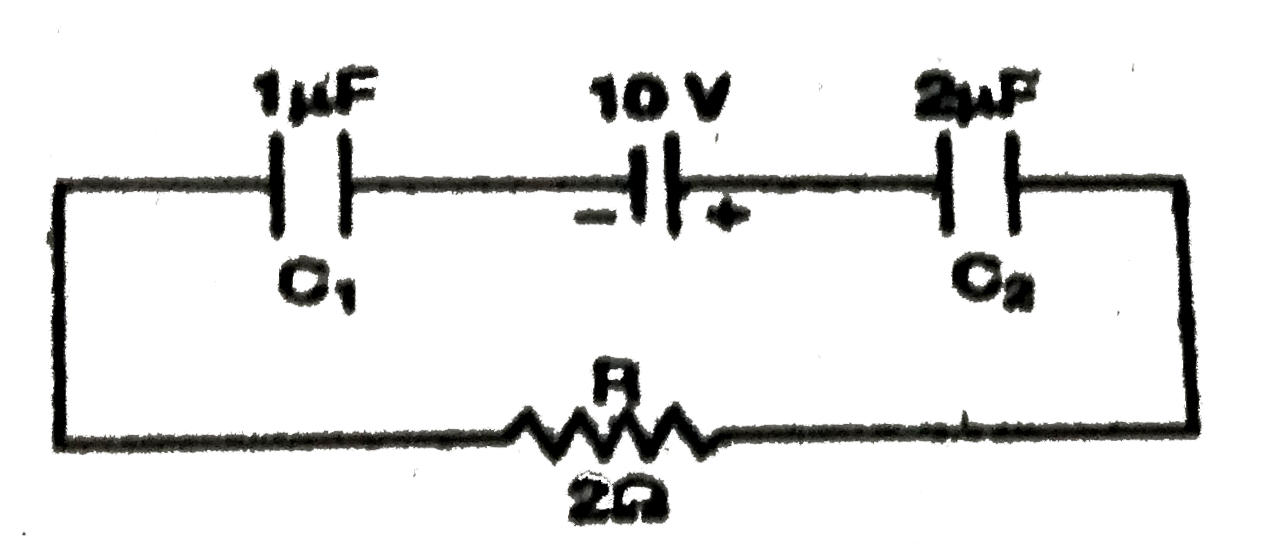Does the capacitance C of a capacitor increase , decrease or remain the same (a) when the charge q on it is doubled and (b) when the potential difference V across it is tripled?
To solve the question regarding the capacitance of a capacitor when the charge q is doubled and when the potential difference V is tripled, we will analyze each part step by step.
1. Initial Condition: Let the initial charge be q1 and the initial potential difference be V1. The initial capacitance C1 is given by:
C1=q1V1
2. New Condition: If the charge is doubled, the new charge q2 becomes:
q2=2q1
3. Capacitance with New Charge: The capacitance with the new charge, assuming the potential difference remains constant, is:
C2=q2V1=2q1V1=2⋅q1V1=2C1
However, since capacitance is a property of the capacitor itself, it does not change with the amount of charge stored. Thus, the capacitance remains the same.
Conclusion for (a): The capacitance remains the same.
---
(b) When the potential difference V across it is tripled:
1. Initial Condition: Using the same initial conditions, the capacitance C1 is:
C1=q1V1
2. New Condition: If the potential difference is tripled, the new potential difference V2 becomes:
V2=3V1
3. Capacitance with New Potential Difference: The capacitance with the new potential difference, assuming the charge remains constant, is:
C2=q1V2=q13V1=13⋅q1V1=13C1
However, similar to the previous case, capacitance is a characteristic of the capacitor and does not change with the applied voltage.
Conclusion for (b): The capacitance remains the same.
---
Final Answer:
- (a) The capacitance remains the same when the charge is doubled.
- (b) The capacitance remains the same when the potential difference is tripled.
---
C1=q1V1
q2=2q1
C2=q2V1=2q1V1=2⋅q1V1=2C1
However, since capacitance is a property of the capacitor itself, it does not change with the amount of charge stored. Thus, the capacitance remains the same.
C1=q1V1
V2=3V1
C2=q1V2=q13V1=13⋅q1V1=13C1
However, similar to the previous case, capacitance is a characteristic of the capacitor and does not change with the applied voltage.
- (a) The capacitance remains the same when the charge is doubled.
- (b) The capacitance remains the same when the potential difference is tripled.
Topper's Solved these Questions
- CAPACITANCEBOOK - RESNICK AND HALLIDAYCHAPTER - CAPACITANCEEXERCISE - PROBLEMS
48 Videos
- CAPACITANCEBOOK - RESNICK AND HALLIDAYCHAPTER - CAPACITANCEEXERCISE - PRACTICE QUESTIONS (SINGLE CORRECT CHOICE TYPE)
23 Videos
- CAPACITANCEBOOK - RESNICK AND HALLIDAYCHAPTER - CAPACITANCEEXERCISE - PRACTICE QUESTION (INTEGER TYPE)
3 Videos
- ALL ABOUT ATOMS BOOK - RESNICK AND HALLIDAYCHAPTER - ALL ABOUT ATOMS EXERCISE - CHECKPOINT
1 Videos
- CENTER OF MASS BOOK - RESNICK AND HALLIDAYCHAPTER - CENTER OF MASS EXERCISE - Practice Questions (Integer )
4 Videos
Similar Questions
For capacitors charged by the same battery, does the charge stored by the capacitor increase , decrease or remain the same in each of the following situations? (a) the plate separation of a parallel plate capacitor is increased b) the radius of the inner cylinder capacitor is increased (c ) the radius of the outer spherical shell of a capacitor is increased.
View SolutionExplain what happens to the capacitance of a capacitor when charge q on it is doubled.
View Solution
Knowledge Check
Find the work done (in J) when a charge of 24 C moves across a potential difference of 6 V.
A4B72C8D144Find the work done (in J) when a charge of 20 C moves across a potential difference of 4 V.
A5B40C80D10A 10V battery is connected to two capacitors C1 and C2 and a resistor R. When the capacitors are fully charged, then the potential difference across the resistor will be
 A10 VB5VC3.33 VDzero
A10 VB5VC3.33 VDzero
In figure C1=C5=8.4μF and C2=C3=C4=4.2μF.The applied potential is Vab=220V

(a) What is the equivalent capacitance of the network between points a and b?
(b) Calculate the charge on each capacitor and the potential difference across each capacitor.
View SolutionA capacitor of capacity 2μF is charged to a potential difference of 12V. It is then connected across an inductor of inductance 6μH. What is the current (in A) in the circuit at a time when the potential difference across the capacitor is 6.0V?
View SolutionFor an isolated parallel plate capacitor of capacitance C and potential difference V, what will be change in (i) charge on the plates (ii) potential difference across the plates (iii) electric field between the plates (iv) energy stored in the capacitor, when the distance between the plates is increased ?
View SolutionA capacitor of capacitance C is charged to a potential difference V from a cell and then disconnected from it. A charge +Q is now given to its positive plate. The potential difference across the capacitor is now
View SolutionA capacitor of capacitance C is charged to a potential difference V from a cell and then disconnected from it. A charge +Q is now given to its positive plate. The potential difference across the capacitor is now
View Solution
